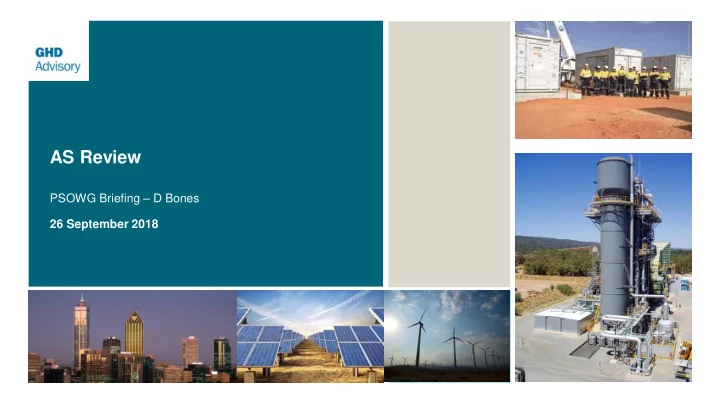

AS Review PSOWG Briefing – D Bones 26 September 2018
Objective: Overview of AS review GHD Scope Outline • Guiding Principles • Key Issues • Approach • Initial progress • Next steps 2 Click to insert Document Title GHD Advisory
Guiding Principles • 10 principles circulated to PSOWG • Key aspects • Built on existing market objectives • AS that support system security • AS that are robust to future uncertainty • AS definitions technology neutral • AS appropriate for the SWIS • Are the guiding principles appropriate • required clarifications? • required modifications? 3 Click to insert Document Title GHD Advisory
Key Issues – Current Issues • Previous reviews have identified key issues (description, causes, proposed strategy) • Classified into • Current issue – visible today on the SWIS • Emerging in the short term – over the next 10 years • Key Current Issues • Frequency Operating Standard (FOS), AS Standards and definitions • FOS subject to change (eg may need to include RoCoF target) • Lack of alignment between FOS and AS requirements, standards and definitions • Tighter alignment required and will facilitate evolution of arrangements • Droop requirements • Mandatory requirement vs market arrangement simulations to investigate actual droop response from generators not contracted for SR • Mandatory dead band within normal frequency band help with frequency regulation demonstrate relative effectiveness of droop response and other services • Contingency frequency response – Spinning Reserve and Load Rejection • Services should be technology neutral and better aligned with FOS modelling to demonstrate optimum mix of services to meet FOS • Frequency regulation - Load Following • Better alignment of service definition and FOS + dynamic requirement optimized to anticipated generation and load conditions • Ready Reserve Service • Review relevancy of the standard and how this relates to provision of Ancillary Services • Credible contingency events • When should non-credible events be deemed credible and taken into account in setting requirements informed by the development of dynamic service requirements 4 Click to insert Document Title GHD Advisory
Key Issues – Short Term Issues • Key Short Term Issues • Rate of Change of Frequency (RoCoF) and System Inertia • No target RoCoF in FOS • RoCoF likely increase with declining synchronous inertia • Demonstrate how services requirements could be set to achieve target RoCoF • Identify when RoCoF may become a critical issue for SWIS • System Strength and Rate of Change of Voltage • System Strength likely to reduce with more inverter connected generation, while RoCoV increases • Studies to identify where and when system strength issues are likely to arise • Locational aspect may preclude use of ancillary service to address issue • Co-optimization of Energy and AS • Implementation beyond GHD scope but requirements should be specified where possible to allow co-optimization • Definition of AS • Timeframes in definitions inconsistent with 5 min dispatch service definitions support move to 5 min dispatch • AS Types and Emerging Technologies • Technology neutrality report capability or existing and emerging technologies including DER to provide AS 5 Click to insert Document Title GHD Advisory
Approach Separately considering frequency regulation and Frequency regulation contingency frequency response • Frequency Regulation • Statistical analysis and data mining • 2018 LFAS review recommended using forecast error • Forecast performance to set regulation requirement • • 5 min forecast error load, embedded Demand + large scale renewables • Predicting variability dynamic requirement PV, large scale wind and solar generation • Ability to predict requirement • Contingency Frequency Response • Time domain studies to investigate optimum mix of services to deliver FOS DIgSILENT Powerfactory • WP detailed model individual gen responses • Develop equivalent lumped model • Demonstrate service types and investigate optimal • Simulation of contingency events combinations to deliver FOS • Detailed WP model lumped model • Test robustness to unexpected conditions • Demonstration of service types • Specify dynamic requirements • Optimum combination FOS • DIgSilent model also allows used to investigate • Ability to predict requirements system strength 6 Click to insert Document Title GHD Advisory
Initial Progress - Regulation Initial focus investigating whether wind forecast variability a reliable predictor of forecast error and hence frequency regulation requirement 7 Click to insert Document Title GHD Advisory
Initial Progress – Contingency Response The 4.5 GW case peak summer demand case in the WP DIgSILENT PowerFactory model Added 450 MW wind reduced generation in quasi merit order Simulated loss of largest generator Adjusted dispatch to provide various levels of C- FCAS: • SR > 70% of generation contingency (generators providing mandatory response) (blue) • SR = 70% of generation contingency (dispatch adjusted to limit governor range (grey) • SR = droop + UFLS • 24 generators contributing droop response Case repeated with generation dispatched so that the droop response was available from seven generators. Response influenced by which generators have available governing range. The simulation illustrates various contributions to restoring frequency following the contingency Yet to include the simulation of the response from generators controlled by AGC Similar result found for 2.7 GW case 8 Click to insert Document Title GHD Advisory
Next Steps Regulation • Expand analysis to consider PV and load variability • Document wind variability analysis • Present conclusions predictability of requirements linked to FOS Contingency • Develop lumped model tuned to give performance aligned to detailed model • Integrate AGC model to allow realistic contingency simulations (20s) • Simulate representative scenarios typical and more extreme conditions • Combinations of services that meet FOS • Requirements that allow co-optimal energy and AS dispatch • Document results and conclusions 9 Click to insert Document Title GHD Advisory
Feedback Questions to prompt discussion • Are the guiding principles appropriate – any clarifications/modifications required • Are there additional issues that need to be considered? • Is the approach reasonable? • Does the approach uncover the key technical information necessary to understand current and future AS requirements? 10 Click to insert Document Title GHD Advisory
ghd.com/advisory
Recommend
More recommend